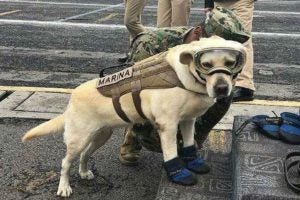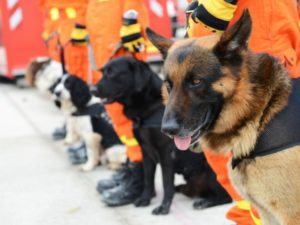

Learning Objectives
Students will create inequalities using two or more variables to represent relationships between quantities.
Grade Levels
Grades 9-12
Common Core Standard
CCSS.MATH.CONTENT.HSA.CED.A.3
Represent constraints by equations or inequalities, and by systems of equations and/or inequalities, and interpret solutions as viable or nonviable options in a modeling context.
Materials Needed
Document camera (at teacher’s discretion)
Lesson Plan
Warm Up
Present the following question to students:
“What could this inequality represent? x + 3y < 32”
Students think pair share to come up with possible responses and share with the class. Example: x is the cost of one brand of dog food and y is the cost of another brand. If you buy three of the second brand and one of the first brand, together they cost less than $32.
Teacher Modeling/Explicit Instruction
In today’s lesson, we will write inequalities to represent situations with Working Dogs.
Search and Rescue dogs provide invaluable help locating missing people after natural disasters or other incidents. They are specially trained to search for people buried in rubble. In order to be able to do this, they must be able to follow commands even when out of sight of their trainer. The US Department of Homeland Security provides guidelines for training SAR dogs. In the guidelines they describe a course that trainers can build that gives dogs the opportunity to practice leaving the trainer’s side and traveling to various levels and distances from the trainer, while still following commands to go, stay, or come.
The course requires four platforms that are two feet by three feet in area, at various heights, from 15 to 30 inches off the ground. This course helps dogs learn how to rescue survivors in a building collapse, where there are various levels to search in. Below is an image of a possible course layout, from the FEMA Canine Specialist Guidelines
A trainer, Miranda, wants to build a course on her property to train German Shepherds and Labrador Retrievers to be Search and Rescue Dogs. In order to support each of the four required platforms, she needs four 4×4 posts.
Miranda found a store that sells four by four posts in lengths of 8 feet for $8.64. She verified that she can get the posts cut at the store and doesn’t have to buy all 8 feet.
Miranda is going to make four platforms at two different heights, and she wants to spend no more than $32.00. She will make two different height platforms, two for each height. What heights can she make each platform?
Students think pair share with a partner to come up with the variables that can represent each different post height.
Example: x=smaller height in inches y= taller height in inches
Check for student understanding of what each variable represents. Have students write an inequality to represent the heights of posts Miranda will need. Students may need a reminder to factor in the cost per inch of the posts.
For example, students may write 8x + 8y < 32. However, the variables given only represent heights in inches while the 32 is a dollar amount. Students need to include the price per inch of each post in their inequality. It is 9 cents per inch for the 4×4 posts.
Example: (.09)8x + (.09)8y < 32 OR 8x + 8y < 32/.09
Then provide the following information.
The shorter platform will be 7 inches shorter than the taller platform.
Ask students for suggestions about how to represent the new information in the inequality. Students need to incorporate the information about the taller posts in terms of the shorter post.
Example: y= x + 7 because the taller post is 7 inches taller than the shorter post OR x= y – 7
Students now should rewrite the inequality either in terms of x or y, not both. As students discus with their partners which way they want to rewrite the inequality, talk about which may be preferable and why. Ask students if either way would be more helpful when graphing the inequality.
Example: 8x + 8(x+7) < 355.56
Students may solve for x algebraically.
Simplifies to 16x + 56 < 355.56
Students solve for x by subtracting 56 from both sides and then dividing by 16 on both sides, resulting in 15 < x < 18.72 inches
Using substitutions students solve for y by adding 18.72 + 7, resulting in 15 < y < 25.72
Independent Practice
Present students with the following scenario.
Andrea builds the ramps and platforms for training German Shepherds to be Search and Rescue dogs. She wants to spend no more than $60 on the wood for this part of the course. She can’t fit more than 24 linear feet of both kinds of plywood sheeting in her workspace. The ramps require 3 linear feet of narrow plywood sheeting each, and the platforms require 4 linear feet of wide plywood sheeting each. Narrow plywood sheeting costs $2 per ramp, and wide plywood sheeting costs $6 per platform. How many ramps and platforms can she make, while keeping her costs at or under $60?
As students work through this problem, they may need reminders to name the variables and constraints in this scenario.
Ask students why this scenario requires inequalities rather than equations.
Example Solution: x = number of ramps y = number of platforms
3x + 4y < 24 and 2x + 6y < 60
Next steps: Graph the inequalities to find the solution set, or solve algebraically.
Closing
Review the steps required for these problems: identify the variables and the constraints; create equations or inequalities based on the problem’s constraints. The next lesson would involve solving the equations/inequalities by graphing or algebraically.
References
FEMA Canine Specialist Guidelines Retrieved from http://www.sardogsus.org/id17.html
For more information about Search and Rescue dogs visit
https://www.dhs.gov/publication/canine-explosives-detection-program
https://www.akc.org/public-education/resources/general-tips-information/service-therapy-work-dogs/

